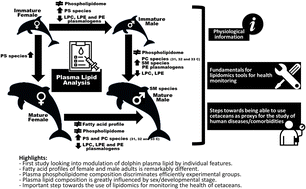The plasma phospholipidome of the bottlenose dolphin (Tursiops truncatus) is modulated by both sex and developmental stage†
Abstract
Lipidomics represent a valid complementary tool to the biochemical analysis of plasma in humans. However, in cetaceans, these tools have been unexplored. Here, we evaluated how the plasma lipid composition of Tursiops truncatus is modulated by developmental stage and sex, aiming at a potential use of lipidomics in integrated strategies to monitor cetacean health. We characterized the fatty acid profile and detected a total of 26 fatty acids in T. truncatus plasma. The most abundant fatty acids were palmitic acid (C16:0), stearic acid (C18:0) and oleic acid (C18:1n-9). Interestingly, there are consistent differences between the fatty acid profile of mature female and mature male specimens. Phospholipidome analysis identified 320 different lipid species belonging to phosphatidylcholine (PC, 105 lipid species), lysophosphatidylcholine (42), phosphatidylethanolamine (PE, 67), lysophosphatidylethanolamine (18), phosphatidylglycerol (14), lysophosphatidylglycerol (8), phosphatidylinositol (14), lysophosphatidylinositol (2), phosphatidylserine (3), sphingomyelin (45) and ceramides (2) classes. The statistical analysis of the phospholipidome showed that its composition allows discriminating mature animals between sexes and mature males from immature males. Notably, discrimination between sexes is mainly determined by the contents of PE plasmalogens and lysophospholipids (LPC and LPE), while the differences between mature and immature male animals were mainly determined by the levels of PC lipids. This is the first time that a correlation between developmental stage and sex and the lipid composition of the plasma has been established in cetaceans. Being able to discern between age and sex-related changes is an encouraging step towards using these tools to also detect differences related to disease/dysfunction processes.



 Please wait while we load your content...
Please wait while we load your content...